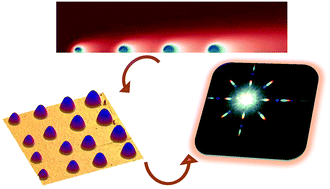Our official English website, www.x-mol.net, welcomes your
feedback! (Note: you will need to create a separate account there.)
Flow-induced dissolution of femtoliter surface droplet arrays
Lab on a Chip ( IF 6.1 ) Pub Date : 2018-02-20 00:00:00 , DOI: 10.1039/c7lc01321c Lei Bao 1, 2, 3, 4, 5 , Vamsi Spandan 6, 7, 8, 9, 10 , Yantao Yang 11, 12, 13, 14, 15 , Brendan Dyett 1, 2, 3, 4, 5 , Roberto Verzicco 6, 7, 8, 9, 10 , Detlef Lohse 6, 7, 8, 9, 10 , Xuehua Zhang 16, 17, 18, 19, 20
Lab on a Chip ( IF 6.1 ) Pub Date : 2018-02-20 00:00:00 , DOI: 10.1039/c7lc01321c Lei Bao 1, 2, 3, 4, 5 , Vamsi Spandan 6, 7, 8, 9, 10 , Yantao Yang 11, 12, 13, 14, 15 , Brendan Dyett 1, 2, 3, 4, 5 , Roberto Verzicco 6, 7, 8, 9, 10 , Detlef Lohse 6, 7, 8, 9, 10 , Xuehua Zhang 16, 17, 18, 19, 20
Affiliation

|
The dissolution of liquid nanodroplets is a crucial step in many applied processes, such as separation and dispersion in the food industry, crystal formation of pharmaceutical products, concentrating and analysis in medical diagnosis, and drug delivery in aerosols. In this work, using both experiments and numerical simulations, we quantitatively study the dissolution dynamics of femtoliter surface droplets in a highly ordered array under a uniform flow. Our results show that the dissolution of femtoliter droplets strongly depends on their spatial positions relative to the flow direction, drop-to-drop spacing in the array, and the imposed flow rate. In some particular cases, the droplet at the edge of the array can dissolve about 30% faster than the ones located near the centre. The dissolution rate of the droplet increases by 60% as the inter-droplet spacing is increased from 2.5 μm to 20 μm. Moreover, the droplets close to the front of the flow commence to shrink earlier than those droplets in the center of the array. The average dissolution rate is faster for the faster flow. As a result, the dissolution time (Ti) decreases with the Reynolds number (Re) of the flow as Ti ∝ Re−3/4. The experimental results are in good agreement with the numerical simulations where the advection–diffusion equation for the concentration field is solved and the concentration gradient on the surface of the drop is computed. The findings suggest potential approaches to manipulate nanodroplet sizes in droplet arrays simply by dissolution controlled by an external flow. The obtained droplets with varying curvatures may serve as templates for generating multifocal microlenses in one array.
中文翻译:

飞升表面液滴阵列的流动诱导溶解
液体纳米滴的溶解是许多应用过程中的关键步骤,例如食品工业中的分离和分散,药物产品的晶体形成,医学诊断中的浓缩和分析以及气雾剂中的药物输送。在这项工作中,同时使用实验和数值模拟,我们定量研究了在均匀流动下以高度有序阵列排列的飞升表面液滴的溶解动力学。我们的结果表明,飞升液滴的溶解在很大程度上取决于其相对于流动方向的空间位置,阵列中的液滴间距以及施加的流速。在某些特定情况下,位于阵列边缘的液滴的溶解速度比位于中心的液滴的溶解速度快约30%。随着液滴间间距从2.5μm增加到20μm,液滴的溶出率提高60%。而且,靠近流的前部的液滴开始比阵列中心处的液滴更早地收缩。平均溶出速度越快,流动速度越快。结果,溶解时间(T i)随流的雷诺数(Re)减小为T i ∝ Re -3/4。实验结果与数值模拟非常吻合,其中求解了浓度场的对流扩散方程,并计算了液滴表面的浓度梯度。研究结果表明,潜在的方法可以简单地通过由外部流控制的溶解来控制液滴阵列中的纳米液滴大小。所获得的具有变化的曲率的液滴可以用作用于在一个阵列中产生多焦点微透镜的模板。
更新日期:2018-02-20
中文翻译:

飞升表面液滴阵列的流动诱导溶解
液体纳米滴的溶解是许多应用过程中的关键步骤,例如食品工业中的分离和分散,药物产品的晶体形成,医学诊断中的浓缩和分析以及气雾剂中的药物输送。在这项工作中,同时使用实验和数值模拟,我们定量研究了在均匀流动下以高度有序阵列排列的飞升表面液滴的溶解动力学。我们的结果表明,飞升液滴的溶解在很大程度上取决于其相对于流动方向的空间位置,阵列中的液滴间距以及施加的流速。在某些特定情况下,位于阵列边缘的液滴的溶解速度比位于中心的液滴的溶解速度快约30%。随着液滴间间距从2.5μm增加到20μm,液滴的溶出率提高60%。而且,靠近流的前部的液滴开始比阵列中心处的液滴更早地收缩。平均溶出速度越快,流动速度越快。结果,溶解时间(T i)随流的雷诺数(Re)减小为T i ∝ Re -3/4。实验结果与数值模拟非常吻合,其中求解了浓度场的对流扩散方程,并计算了液滴表面的浓度梯度。研究结果表明,潜在的方法可以简单地通过由外部流控制的溶解来控制液滴阵列中的纳米液滴大小。所获得的具有变化的曲率的液滴可以用作用于在一个阵列中产生多焦点微透镜的模板。











































 京公网安备 11010802027423号
京公网安备 11010802027423号